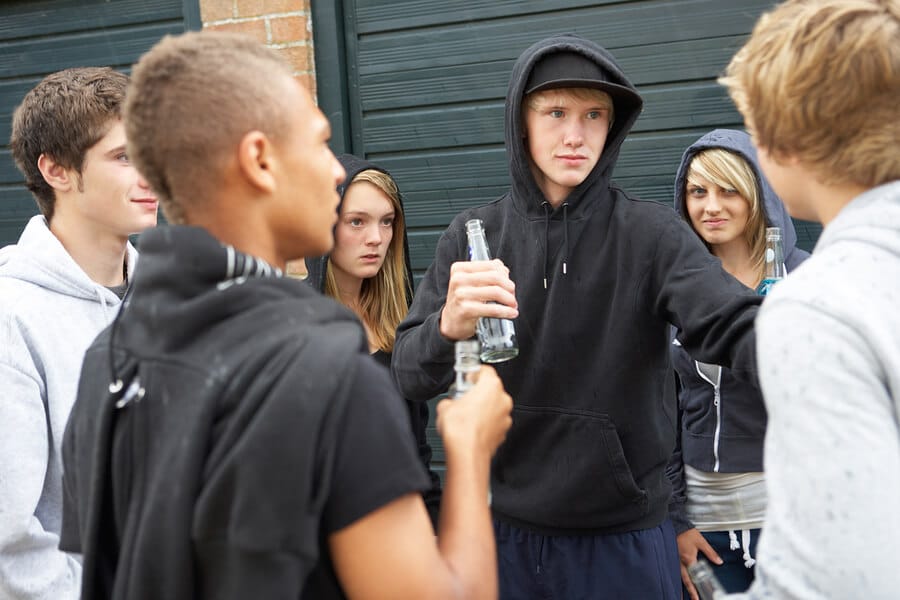
Teenage alcoholism is a common problem that, tragically, is related to thousands of fatalities each year. Even those teenagers who are not yet dependent on alcohol are more likely to develop an alcohol use disorder later in life if they start drinking at an early age.
Teenage Alcoholism: A Widespread Problem
Although alcohol addiction is more often thought of as an adult disorder, teenage alcoholism is a very real and prevalent problem. Alcohol is the most commonly abused substance in the world, including for those under age 21. And, although the number of U.S. teens who drink has been decreasing in recent years, there are still millions of underage drinkers in the country.
Indeed, more than half of Americans between 12-20 years old report having experimented with alcohol, and 1 in 5 teens become excessive drinkers. According to the Substance Abuse and Mental Health Services Administration (SAMHSA), in 2010 there were approximately 10 million underage drinkers in the U.S.—among those, 6.5 million engaged in binge drinking and two million were heavy drinkers.
In addition to the many adverse health impacts that are directly the result of drinking, young drinkers are especially susceptible to deaths related to excessive alcohol use. According to the Center on Alcohol Marketing and Youth, every year 5,000 people 21 and under die from alcohol-related injuries, including suicide and homicide, and an additional 600,000 were injured as a result of alcohol abuse.
Warning Signs
Common warning signs of teenage alcoholism include the following:
- Drinking alone in isolation
- Hanging out with friends who also drink
- Reckless and impulsive behavior
- Drinking with increased frequency and amount per episode
- Making excuses for alcohol use
- Profound changes in behavior
- Withdrawal from friends and family
Teenage Binge Drinking
Due to inexperience with alcohol use, a lower objection to risk, and vulnerability to peer pressure, teens have a significantly higher risk of binge drinking than many other age groups. Binge drinking is defined as the consumption of at least 4-5 or more alcoholic beverages in under two hours. Binge drinking affects the whole body and induces uncomfortable symptoms such as nausea and vomiting, hangovers, headaches, and low energy.
Unfortunately, 45 percent of 9th graders, half of all 10th graders, 58 percent of 11th graders and 65 percent of 12th graders report having engaged in binge drinking at least once during their lives.
Although binge drinking does not necessarily equate to full-blown alcohol addiction, it is one of the main contributing factors to teenage alcoholism. Binge drinking increases a person’s tolerance to alcohol, and once this occurs, young drinkers can easily become dependent on alcohol, either while still underage or in their adult years.
Researchers suggest that adolescents are more likely than adults to misuse alcohol because of the way the human brain develops. The teenage brain’s pleasure centers develop more rapidly than the part of the brain responsible for decision-making. Teens are particularly susceptible to binge drinking because their impulse control ability has not yet fully matured.
Moreover, many adolescents do not have the mental capacity to fully comprehend the consequences of drinking or even be actively aware of them. Teens can encounter immediate adverse effects, such as brain damage and delayed puberty. Indirect injuries, such as car crashes and sexual assaults, are also common problems from drinking.

Risks of Teenage Drinking
Alcohol consumption places teens at risk for many different adverse consequences. Drinking large amounts of alcohol while the brain is still developing will stunt personal growth. This damage can make it very difficult to successfully manage responsibilities at school and home, potentially impacting one’s future in negative ways.
Teenagers who drink have a higher risk of the following consequences, in addition to many others:
- Impaired memory
- Experiencing mood swings
- Acute alcohol poisoning
- Damaging property
- Car accident
- Damaging organs
- Poor academic performance
- Drug experimentation
- Sexual assault
- Risky sexual behavior
- Engaging in violence
- Attempting suicide
Risk Factors for Teenage Alcoholism
People who begin consuming alcohol at a young age are more likely to develop a dependence on alcohol later in life. Although no one is immune to developing a problem, some factors can increase the likelihood that a young person will engage in alcohol abuse, including the following:
Genetics – Teenagers who have parents or siblings that have an alcohol use disorder are as much as four times more likely to develop a problem of their own.
External pressure – Teenagers whose parents, siblings or friends are heavy drinkers are more likely to initiate drinking earlier and believe that this behavior is normal and acceptable.
Personality – Adolescents who believe alcohol use increases sociability or likeability are more likely to drink to excess in an effort to fit in.
Treating Teenage Alcoholism
Underage drinking can expose teens to a myriad of consequences, but there is hope. If your teen exhibits signs of alcoholism or changes in behavior due to increased alcohol abuse, contact a treatment provider immediately. Addiction professionals can help parents find the right facility with adolescent treatment programs and evidence-based therapies designed for their teens.
If you or someone you love is addicted to drugs or alcohol, contact Harmony Treatment and Wellness today. Discover how we help people free themselves from the grip of addiction so they can begin to experience the healthy and fulfilling lives they deserve!
Related: How to Help an Alcoholic
